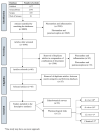Plectranthus Species with Anti-Inflammatory and Analgesic Potential: A Systematic Review on Ethnobotanical and Pharmacological Findings
- PMID: 37570622
- PMCID: PMC10419981
- DOI: 10.3390/molecules28155653
Plectranthus Species with Anti-Inflammatory and Analgesic Potential: A Systematic Review on Ethnobotanical and Pharmacological Findings
Abstract
The use of medicinal plants to treat inflammatory conditions and painful processes has attracted the attention of scientists and health professionals due to the evidence that natural products can promote significant therapeutic benefits associated with fewer adverse effects compared to conventional anti-inflammatory drugs. The genus Plectranthus is composed of various plants with pharmacological potential, which are used to treat various diseases in traditional communities worldwide. The present study systematically reviewed Plectranthus species with anti-inflammatory and analgesic potential. To this end, a systematic review was conducted following the Preferred Reporting Items for Systematic Reviews and Meta-Analyses (PRISMA) protocol. The search was conducted on the following databases: PubMed, ScienceDirect, SciVerse Scopus, and Web of Science. Different combinations of search terms were used to ensure more excellent article coverage. After the selection, a total of 45 articles were included in this review. This study identified twelve Plectranthus species indicated for the treatment of different inflammatory conditions, such as wounds, fever, bronchitis, abscess, asthma, hepatitis, labyrinthitis, tonsillitis, and uterine inflammation. The indications for pain conditions included headache, sore throat, heartburn, menstrual cramp, colic, toothache, stomachache, migraine, chest pain, abdominal pain, local pain, labor pain, and recurring pain. Among the listed species, ten plants were found to be used according to traditional knowledge, although only four of them have been experimentally studied. When assessing the methodological quality of preclinical in vivo assays, most items presented a risk of bias. The SR results revealed the existence of different Plectranthus species used to treat inflammation and pain. The results of this systematic review indicate that Plectranthus species have the potential to be used in the treatment of diseases with an inflammatory component, as well as in the management of pain. However, given the risk of biases, the experimental analysis of these species through preclinical testing is crucial for their safe and effective use.
Keywords: Plectranthus; ethnobotany; ethnopharmacology; inflammation; nociception; pharmacological trials; systematic review.
Conflict of interest statement
The authors declare no conflict of interest.
Figures



Similar articles
-
Systemic pharmacological treatments for chronic plaque psoriasis: a network meta-analysis.Cochrane Database Syst Rev. 2021 Apr 19;4(4):CD011535. doi: 10.1002/14651858.CD011535.pub4. Cochrane Database Syst Rev. 2021. Update in: Cochrane Database Syst Rev. 2022 May 23;5:CD011535. doi: 10.1002/14651858.CD011535.pub5. PMID: 33871055 Free PMC article. Updated.
-
Pain management for women in labour: an overview of systematic reviews.Cochrane Database Syst Rev. 2012 Mar 14;2012(3):CD009234. doi: 10.1002/14651858.CD009234.pub2. Cochrane Database Syst Rev. 2012. PMID: 22419342 Free PMC article.
-
Home treatment for mental health problems: a systematic review.Health Technol Assess. 2001;5(15):1-139. doi: 10.3310/hta5150. Health Technol Assess. 2001. PMID: 11532236
-
Systemic pharmacological treatments for chronic plaque psoriasis: a network meta-analysis.Cochrane Database Syst Rev. 2017 Dec 22;12(12):CD011535. doi: 10.1002/14651858.CD011535.pub2. Cochrane Database Syst Rev. 2017. Update in: Cochrane Database Syst Rev. 2020 Jan 9;1:CD011535. doi: 10.1002/14651858.CD011535.pub3. PMID: 29271481 Free PMC article. Updated.
-
Cost-effectiveness of using prognostic information to select women with breast cancer for adjuvant systemic therapy.Health Technol Assess. 2006 Sep;10(34):iii-iv, ix-xi, 1-204. doi: 10.3310/hta10340. Health Technol Assess. 2006. PMID: 16959170
Cited by
-
Biological Properties of Extracts Obtained from In Vitro Culture of Plectranthus scutellarioides in a Cell Model.Int J Mol Sci. 2024 Jan 15;25(2):1043. doi: 10.3390/ijms25021043. Int J Mol Sci. 2024. PMID: 38256118 Free PMC article.
-
Anticancer Effects of Abietane Diterpene 7α-Acetoxy-6β-hydroxyroyleanone from Plectranthus grandidentatus and Its Semi-Synthetic Analogs: An In Silico Computational Approach.Molecules. 2024 Apr 16;29(8):1807. doi: 10.3390/molecules29081807. Molecules. 2024. PMID: 38675627 Free PMC article.
References
-
- Sales M.D.C., Sartor E.B., Gentilli R.M. Ethnobotany and ethnopharmacology: Traditional medicine and the bioprospection of phytotherapics. Salus J. Health Sci. 2015;1:17–25. doi: 10.5935/2447-7826.20150003. - DOI
-
- Saggar S., Mir P.A., Kumar N., Chawla A., Uppal J., Shilpa S., Kaur A. Traditional and Herbal Medicines: Opportunities and Challenges. Pharmacogn. Res. 2022;14:107–114. doi: 10.5530/pres.14.2.15. - DOI
-
- Marmitt D.J., Rempel C., Goettert M.I., Silva A.D.C.E. Plantas Medicinais da RENISUS Com Potencial Anti-inflamatório: Revisão Sistemática Em Três Bases de Dados Científicas. Rev. Fitos. 2015;9:129–144. doi: 10.5935/2446-4775.20150011. - DOI
Publication types
MeSH terms
Substances
LinkOut - more resources
Full Text Sources
Medical
Research Materials

